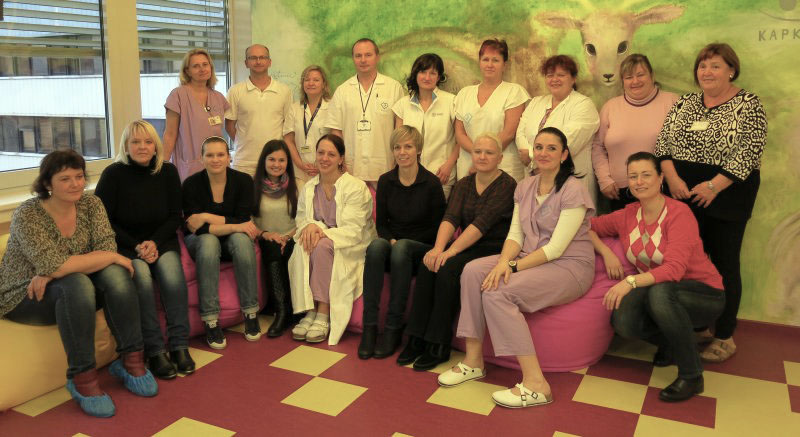Transplantation
Bone marrow transplantation (or hematopoietic stem cell transfer) is one of the treatments for children with hematopoietic malignancies, bone marrow failure due to acquired or inherited predisposition, severe immune system disorders, or metabolism.
Most often (about 65% of procedures) we perform transplants in children with leukemia who do not respond well to treatment or have reappeared after previous successful chemotherapy. Patients are given the hematopoietic and immune cells of a healthy donor, we are talking about the so-called allogeneic transplantation. The donor can be a family member (usually a suitable sibling) or an unrelated donor from the registry.
We usually do not perform allogeneic transplantation in children with solid tumors - the transfer of their own stem cells is still part of the treatment of some tumors, typically in high-risk neuroblastoma. These are usually diagnoses where it is necessary to give the patient such aggressive chemotherapy that it practically eliminates his hematopoiesis in the bone marrow. Therefore, hematopoietic cells, which occur naturally in the bone marrow, are removed from the child before starting cytostatic treatment. Shortly after stimulation, they can also occur in the peripheral blood, from where we can also obtain them (by separation). After undergoing aggressive chemotherapy, the patient's own hematopoietic cells (so-called autologous transplantation).
A number of diseases are treated by transplantation:
allogeneic transplantation:
- Acute lymphoblastic leukemia (ALL)
- Acute myeloid leukemia (AML)
- Myelodysplastic syndrome (MDS)
- Chronic myeloid leukemia (CML)
- Hodgkin's lymphoma (HD)
- Non-Hodgkin's Lymphoma (NHL)
- Idiopathic myelofibrosis
- Severe acquired aplastic anemia (SAA)
- Severe combined immunodeficiency (SCID)
- Chronic granulomatosis
- Mucopolysaccharidosis I. and VI. type
- Mucolipidosis
- Adrenoleukodystrophy (COALD)
- Wiskott-Aldrich syndrome
- Congenital erythropoietic porphyria
- Malignant osteopetrosis
- Diamond-Blackfan anemia
- Fanconi anemia with hematopoietic failure or progression to leukemia
- Constitutional anemia
- Malignant infectious mononucleosis
- Familial hemophagocytic lymphohistiocytosis (FHL)
- Paroxysmal nocturnal hemoglobinuria (PNH)
- Systemic rheumatoid arthritis, etc.
autologous transplantation:
- Hodgkin's lymphoma (HD)
- Non-Hodgkin's Lymphoma (NHL)
- Wilms' tumor
- Ewing's sarcoma (PNET)
- Rhabdomyosarcoma (RMS)
- Retinoblastoma
- Neuroblastoma, etc.
Donor selection
For a successful transplant, the donor and patient must have the most similar tissue type possible (HLA character set). The larger the difference in donor and recipient HLA traits (ideally a match in nine or ten traits out of a total of ten tested), the higher the patient's risk of complications. Due to the inheritance of tissue traits, it is possible to find an identical donor in the blood family.
If a suitable donor is not found in the family (75-80% of patients in the family do not have a suitable donor), it is necessary to start searching for an unrelated donor in registers of bone marrow donors in the Czech Republic, but also in foreign European or overseas registers.
Before transplantation
Before the actual transplant, the patient must undergo a number of additional examinations, which will clarify the patient's current state of health, especially the function of individual organs.
The patient then undergoes a special treatment regimen that destroys his existing bone marrow and immune system. It is the administration of very aggressive chemotherapy within a few days (4-8), according to the diagnosis it is sometimes supplemented by whole-body irradiation.
Day D
The actual transfer of hematopoietic stem cells takes place as a standard transfusion. Depending on the type of graft being administered, the transfer takes several minutes (thawed grafts) to many hours, and the stem cells are administered to the patient intravenously through a central catheter. As a rule, the administration of stem cells is not directly accompanied by any complications. The coming days and weeks are crucial for the success of the transplant. The day of transplantation is referred to as day 0, as the following days are counted as D + 1, D + 2, etc.
After the transplant
The post-transplant period is a challenging treatment phase during which the donated hematopoietic cells settle in the patient's body. After transplantation, the patient is at risk for a number of toxic and infectious complications, as his own bone marrow has been destroyed by a pre-transplant regime and newly donated hematopoietic cells are still healing. Logging in Hematopoiesis usually takes 2-4 weeks, but the recovery of the immune system takes many months.
At the transplant unit, patients are hospitalized in a sheltered environment for many weeks. But even after being released into home care, it has not yet been won. Hematopoiesis may work well, but the immune system can damage some tissues and organs in the recipient (graft-versus-host disease) or is not yet strong enough and cannot protect recipients from serious and life-threatening fungal infections or viruses. Therefore, especially during the first months after the transplant, patients are very often examined in an outpatient clinic and some of them need hospital care again for various health reasons. A stricter hygiene regime for uncomplicated transplants should usually be observed for at least half a year after the transplant.
See for more information education of the Donor Association.
transplant unit team (2014)


